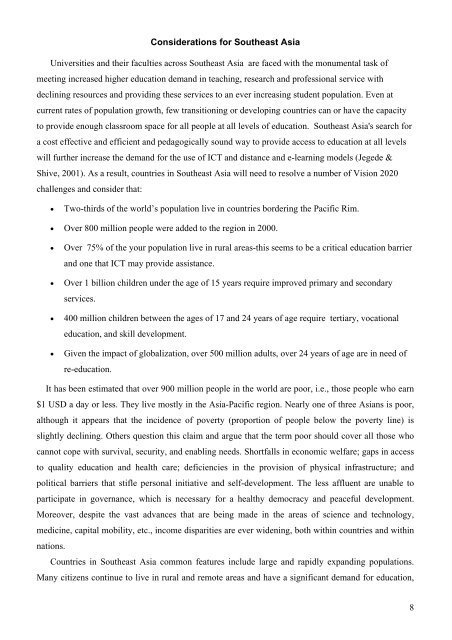The Association of Southeast Asian Institutions of Higher Learning ...
The Association of Southeast Asian Institutions of Higher Learning ...
The Association of Southeast Asian Institutions of Higher Learning ...
You also want an ePaper? Increase the reach of your titles
YUMPU automatically turns print PDFs into web optimized ePapers that Google loves.
Considerations for <strong>Southeast</strong> AsiaUniversities and their faculties across <strong>Southeast</strong> Asia are faced with the monumental task <strong>of</strong>meeting increased higher education demand in teaching, research and pr<strong>of</strong>essional service withdeclining resources and providing these services to an ever increasing student population. Even atcurrent rates <strong>of</strong> population growth, few transitioning or developing countries can or have the capacityto provide enough classroom space for all people at all levels <strong>of</strong> education. <strong>Southeast</strong> Asia's search fora cost effective and efficient and pedagogically sound way to provide access to education at all levelswill further increase the demand for the use <strong>of</strong> ICT and distance and e-learning models (Jegede &Shive, 2001). As a result, countries in <strong>Southeast</strong> Asia will need to resolve a number <strong>of</strong> Vision 2020challenges and consider that:• Two-thirds <strong>of</strong> the world’s population live in countries bordering the Pacific Rim.• Over 800 million people were added to the region in 2000.• Over 75% <strong>of</strong> the your population live in rural areas-this seems to be a critical education barrierand one that ICT may provide assistance.• Over 1 billion children under the age <strong>of</strong> 15 years require improved primary and secondaryservices.• 400 million children between the ages <strong>of</strong> 17 and 24 years <strong>of</strong> age require tertiary, vocationaleducation, and skill development.• Given the impact <strong>of</strong> globalization, over 500 million adults, over 24 years <strong>of</strong> age are in need <strong>of</strong>re-education.It has been estimated that over 900 million people in the world are poor, i.e., those people who earn$1 USD a day or less. <strong>The</strong>y live mostly in the Asia-Pacific region. Nearly one <strong>of</strong> three <strong>Asian</strong>s is poor,although it appears that the incidence <strong>of</strong> poverty (proportion <strong>of</strong> people below the poverty line) isslightly declining. Others question this claim and argue that the term poor should cover all those whocannot cope with survival, security, and enabling needs. Shortfalls in economic welfare; gaps in accessto quality education and health care; deficiencies in the provision <strong>of</strong> physical infrastructure; andpolitical barriers that stifle personal initiative and self-development. <strong>The</strong> less affluent are unable toparticipate in governance, which is necessary for a healthy democracy and peaceful development.Moreover, despite the vast advances that are being made in the areas <strong>of</strong> science and technology,medicine, capital mobility, etc., income disparities are ever widening, both within countries and withinnations.Countries in <strong>Southeast</strong> Asia common features include large and rapidly expanding populations.Many citizens continue to live in rural and remote areas and have a significant demand for education,8
















